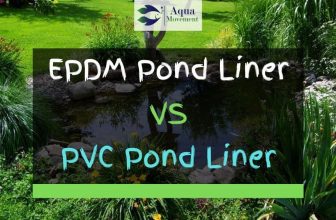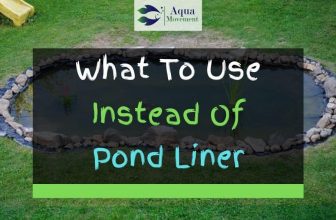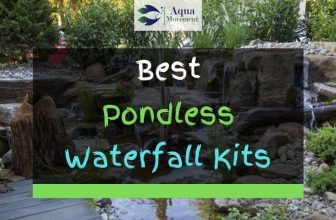13 Best Plants for Koi Ponds – With Pictures
Koi ponds can be an impressive centerpiece to any garden. They are notably attractive and act as a great focal point, drawing your eye immediately. Of course, part of the attraction is the fish that reside in the pond.
Koi fish are a very attractive form of carp that have been selective bred for generations to become the pinnacle of the pond enthusiast’s world. However, part of the attraction is also the pond itself.
The gentle lapping of water and the crystal-clear waves can be a really soul-soothing sight. This can be greatly enhanced by the correct elements of aquatic plants in the pond, which is the topic of this comprehensive article.
There are a number of factors you need to consider when you are choosing plants to try and enhance your koi pond ecosystem.
Of course, you want plants that are going to be aesthetically pleasing and contribute to the overall ‘look’ that you are aiming for.
But you also need plants that are compatible with koi fish, that will grow to reach a decent size, and that will not have harmful repercussions for other species in the pond.
If you follow all the advice given in this article, then you should have no trouble choosing a suitable plant type or two.
Table of Contents
Umbrella Palm Plant (Cyperus Alternifolius)
[amazon box=”B0197642WY”]
Umbrella plants are ideal for large outdoor aquatic environments as they have a natural fondness for marine conditions, and they are resilient to a wide variety of climates and prevailing weather conditions.
They are a natural choice when it comes to populating koi ponds as they provide a large overhanging green canopy, that can provide a great deal of shade and shelter in your pond.
This can help the koi themselves in warmer climates, and they will also attract a host of other species to the pond, which can help build up further depth and diversity in your garden pond.
Water Iris
[amazon box=”B01LAWY17Y”]
This attractive plant does not necessarily need year-round standing water to thrive. It will also do well in wet soils and moderately moist conditions. The natural hardiness of this plant is quite surprising when you view its beautiful and delicate flower.
Like its terrestrial equivalent, it produces a multi-leaf flower that can occur in a variety of beautiful colors.
This can be planted all year round in koi ponds, but autumn planting generally gives the best results, especially when combined with a water-soluble fertilizer.
Make sure any fertilizer or treatment you use is suitable for use in the presence of koi fish, before you add it to the environment.
Horsetail
[amazon box=”B01C81U71U”]
This rush or reed-like plant might not look like much on its own, but when you combine it with other varieties of aquatic plants, they can really add another dimension to your koi pond.
Just remember than these plants spread quickly and like to reproduce, so you will need to be vigilant to make sure it does not claim too much of the pond, reducing the space for your koi fish to roam in.
This aggressive spreading species can grow to be up to 6 feet tall and it isn’t too fussy about the conditions it need to bloom, which is one of the reasons why it has survived for more than 300 million years!
Water Hyacinth
[amazon box=”B012CG9OAQ”]
Unlike the other plants on this list, which have roots attaching them to the underside of the pond, this is a free-floating plant.
Like the horsetail, it has a reputation for being an aggressive invader, and it can sometimes overgrow to claim the entire pond if you don’t keep it in check. In this context, keeping it in check can mean manual clean outs or use of other treatments.
There are a number of advantages to this plant. It has a lovely annual blooming event, and it basically takes care of itself. What’s more, this can actually make for a very tasty snack for your koi fish.
This can be a problem if they indulge too much, but usually if they have a well-planned diet they will only nibble at these plants occasionally, rather than devour them totally.
Water Lettuce
[amazon box=”B012CGJT5Q”]
The reason for this name is pretty obvious once you see an example of this aquatic plant. They greatly resemble a bunch of free-floating lettuce heads bobbing on the surface of the water.
The crinkled green bodies can provide the ideal home for a bunch of visiting critters and locals as well.
They do a wonderful job of absorbing nutrients from the water, which can help to keep the levels of phosphates and nitrate in check. This can help to prevent harmful blooms of algae, which could have a detrimental effect on the health of your koi fish.
As a result, this plant could be a great investment for your koi fish, although it might require some occasional maintenance and upkeep.
Water Lilies
[amazon box=”B07PDR6JQH”]
These are a slightly more attractive, upmarket kind of floating aquatic plant. In fact, they are probably one of the best plants for koi ponds.
Like many other pad-based plants, they can provide a suitable location for koi fish to lay their eggs, helping to provide stability and security for the growing larvae.
They also provide much needed shade and oxygenation for all the fish of the pond, helping them to grow and reach their full potential. Plus, they have a lovely flower when they are in full bloom.
Water Lotus
[amazon box=”B083NCNZDP”]
The traditional water lotus is one of the most sought-after aquatic plants in the world of koi pond enthusiasts. They are slightly larger than water lilies and their flower is even more impressive.
They also provide the same benefits to the koi fish and the ecosystem in general. However, they do have more stringent requirements. They require warm water to grow, at least above 75 deg. F, and they will not survive in harsh frosts.
They also require moderately deep waters and drastic changes in the water hardness or pH could be a blow to their delicate constitutions. However, if you get the balance right, they are definitely worth the fuss.
Water Poppy
[amazon box=”B015OUEUME”]
These perennial plants are another favorite for outdoor ponds in general, and koi ponds in particular. There are a number of reasons for this. Firstly, they need a minimal amount of care.
They are also very easy to obtain, and they will bloom throughout the summer, revealing a soft, three-petalled cream flower that contrasts nicely with the green base.
They will do nicely in a mixed growth of hyacinths, water lilies and other varieties of floating plants.
Fanwort (Cabomba caroliniana)
[amazon box=”B0778Y48T4″]
Fanwort may not be the first thing people consider when they think about the best plants for koi pond, but it should be on any self-respecting top list of aquatic plants.
It might not be the most aesthetically pleasing aquatic plant, but what it lacks in looks it more than makes up for in functionality.
Fanwort serves a real practical purpose by introducing more oxygen to the water, helping to increase the level of dissolved oxygen, allowing the pond to support more life and a more diverse ecosystem.
This has profoundly positive long-term effects on the health of your koi fish.
American Waterweed (Elodea canadensis)
[amazon box=”B07FM9CC93″]
American waterweed is commonly viewed as a plant to be used in small, indoor aquariums, but many people are surprised when they learn it can be used in large scale koi ponds as well. It has a familiar smooth, petal-like appearance.
American Waterweed can grow up to 3 or 4 feet in length where space allows.
It is a very popular snack for fish as well as other critters, so there is a risk that your koi fish might devour it, but that is not too big a risk as it has no harmful effects on their health.
Water Purslane (Ludwigia Palustris)
[amazon box=”B01K1TSLM8″]
Water purslane is a beautiful plant species that can grow on land in wet, peat soils or in submerged aquatic conditions. It is found all over Ireland and Britain, as well as in other parts of Europe.
Water purslane is sometimes considered as an aquatic weed but this belies the real positive effect that it can have on your koi pond.
It can help to line the bottom of any natural or artificial pond, which helps to introduce another source of oxygen in the water, and keep the growth of harmful algae in the water to a minimum.
Water Smartweed
[amazon box=”B01NBOQI2Q”]
This is a common plant found distributed in wetlands all over North America.
It has a rugged nature and can survive even in harsh climates. This means that you can keep it securely outside even if you have to bring your koi in for the winter.
There are lots of different varieties in this family of plants, and they have had a variety of different uses even before their decorative use in domestic ponds.
For instance, in olden times they had a medical use for soothing itchy or enflamed skin, and that is possibly where the name is derived from.
Eelgrass
[amazon box=”B076QKLVK7″]
This is undoubtedly one of the best plants for koi ponds that is widely available anywhere in the world. It is a common perennial plant and has a bit of an unwarranted bad reputation as a weed.
Once levels are kept appropriate to the size of the pond, it can actually have a positive effect on the ecosystem. It provides a nice green background for more colorful aquatic plants to bloom in.
Eelgrass also provides a home for lots of insects and critters which might help your koi to grow. It helps to regulate the levels of nutrients in the water and maintain a healthy equilibrium in the pond.
Benefits Of Plants For Your Koi Pond
Video: “How to Plant Pond Plants”
Having a diverse mix of vegetation and animals in your ecosystem can have a vast amount of complimenting advantages. Aquatic plants are just one crucial part of this mix of things that can directly benefit your ecosystem.
They can have a direct, positive impact on the health of your beloved koi fish, by helping to oxygenate the water as well as keep other substances such as nitrates and phosphates in check.
This means that harmful algae blooms, which tend to strip the oxygen from the water and starve other creatures of the resources they need, are less likely to happy.
Aquatic plants can also provide shelter and protection for other critters such as insects and snails, which either add to the biodiversity or can become a tasty snack for your koi fish.
Koi fish can benefit from installed plants in other ways as well. For instance, female koi fish will often use the underside of floating vegetation as a place to secure their eggs. This is a secure habitat which protects the eggs from the choppiness of the open pond.
Also, you must be aware that whatever plants you install, they may become a food source for your koi fish. They will be partial to some plants more than others, but as relatively non-fussy omnivores they will not hesitate to take a bite out of any plant to try it out.
This shouldn’t do them any harm, and may help to diversify their diet, but it does mean that you shouldn’t become too attached to your aquatic plants!
Conclusion
In this comprehensive article we have outlined the best plants for koi ponds. They add to the spectacle of the pond, improve the ecosystem, and can have direct positive impacts on the well-being of the fish inhabitants.
You should select your aquatic plants carefully. You need to make sure that they are suitable for your local climate and they will not die once the winter comes.
You should also consider how much managed maintenance they require, as some species can rapidly spread and will need to be regularly thinned out.
These are the factors that you might not consider when you are just looking at a picture of their pretty flowers. If you are ever in doubt about the suitability or compatibility of an aquatic plant, check with your local garden center or ask a friendly koi enthusiast.




